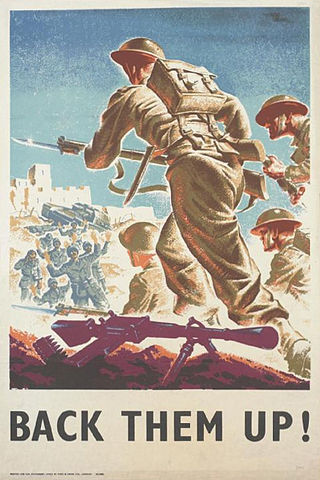Related Research Articles

Operation Market Garden was an Allied military operation during the Second World War fought in the German-occupied Netherlands from 17 to 27 September 1944. Its objective was to create a 64 mi (103 km) salient into German territory with a bridgehead over the Nederrijn, creating an Allied invasion route into northern Germany. This was to be achieved by two sub-operations: seizing nine bridges with combined US and British airborne forces (Market) followed by British land forces swiftly following over the bridges (Garden).

The Bernhardt Line, or Reinhard Line, was a German Army defensive line in Italy during the Italian Campaign of World War II. Having reached the Bernhardt Line at the start of December 1943, it took until mid-January 1944 for the US Fifth Army to fight its way to the next line of defences, the Gustav Line. The Bernhardt Line was defended by XIV Panzer Corps, part of the German Tenth Army.

The military history of the United Kingdom in World War II covers the Second World War against the Axis powers, starting on 3 September 1939 with the declaration of war by the United Kingdom and France, followed by the UK's Dominions, Crown colonies and protectorates on Nazi Germany in response to the invasion of Poland by Germany. There was little, however, the Anglo-French alliance could do or did do to help Poland. The Phoney War culminated in April 1940 with the German invasion of Denmark and Norway. Winston Churchill became prime minister and head of a coalition government in May 1940. The defeat of other European countries followed – Belgium, the Netherlands, Luxembourg and France – alongside the British Expeditionary Force which led to the Dunkirk evacuation in June 1940.
From 1939 to 1940, the French Third Republic was at war with Nazi Germany. In 1940, the German forces defeated the French in the Battle of France. The Germans occupied the north and west of French territory and a collaborationist régime under Philippe Pétain established itself in Vichy. General Charles de Gaulle established a government in exile in London and competed with Vichy France to position himself as the legitimate French government, for control of the French overseas empire and receiving help from French allies. He eventually managed to enlist the support of some French African colonies and later succeeded in bringing together the disparate maquis, colonial regiments, legionnaires, expatriate fighters, and Communist snipers under the Free French Forces in the Allied chain of command. In 1944, after the Allies had landed in Normandy and the southern front moved from North Africa across the Mediterranean into Italy and Provence, these forces routed the German Army, and Vichy officials fled into Germany.

The 15th Army Group was an army group in World War II, composed of the British Eighth Army and initially the Seventh United States Army (1943), replaced by the Fifth United States Army, which apart from units from across the British Empire and United States, also had entire units from other allied countries/regions, including: one corps from Free France and one from Poland; one division from Brazil; multiple separate brigades of Italians and Greeks; plus support to, and from, local Italian partisans. It operated in the Italian Campaign from 1943 to 1945.

The 21st Army Group was a British headquarters formation formed during the Second World War. It controlled two field armies and other supporting units, consisting primarily of the British Second Army and the First Canadian Army. Established in London during July 1943, under the command of Supreme Headquarters Allied Expeditionary Force (SHAEF), it was assigned to Operation Overlord, the Western Allied invasion of Europe, and was an important Allied force in the European Theatre. At various times during its existence, the 21st Army Group had additional British, Canadian, American and Polish field armies or corps attached to it. The 21st Army Group operated in Northern France, Luxembourg, Belgium, the Netherlands and Germany from June 1944 until August 1945, when it was renamed the British Army of the Rhine (BAOR).

XXX Corps was a corps of the British Army during the Second World War. The corps was formed in the Western Desert in September 1941. It provided extensive service in the North African Campaign and many of its units were in action at the Second Battle of El Alamein in late 1942. It then took part in the Tunisia Campaign and formed the left flank during the Allied invasion of Sicily in 1943.

The 1st Canadian Division is a joint operational command and control formation based at CFB Kingston, and falls under Canadian Joint Operations Command. It is a high-readiness unit, able to move on very short notice, and is staffed and equipped to meet Canada’s military objectives to counter any potential threat.

The Siegfried Line campaign was a phase in the Western European campaign of World War II, which involved actions near the German defensive Siegfried Line.

The Anglo-Iraqi War was a British-led Allied military campaign during the Second World War against the Kingdom of Iraq under Rashid Gaylani, who had seized power in the 1941 Iraqi coup d'état with assistance from Germany and Italy. The campaign resulted in the downfall of Gaylani's government, the re-occupation of Iraq by the British, and the return to power of the Regent of Iraq, Prince 'Abd al-Ilah, a British ally.

Field Marshal Sir Richard Amyatt Hull, was a senior British Army officer. He was the last Chief of the Imperial General Staff (CIGS), holding the post from 1961 to 1964, and the first Chief of the General Staff (CGS), holding that post until 1965, and, as such, was the professional head of the British Army. He later became Chief of the Defence Staff (CDS) from 1965 to 1967, the professional head of the entire British Armed Forces. He served with distinction during the Second World War, fighting from 1942 to 1945 in North Africa, Italy and Western Europe, became the youngest divisional commander in the British Army, and, after the war was over, he advised the British government on the response to the Indonesia–Malaysia confrontation in the 1960s.

The history of Canada during World War II begins with the German invasion of Poland on 1 September 1939. While the Canadian Armed Forces were eventually active in nearly every theatre of war, most combat was centred in Italy, Northwestern Europe, and the North Atlantic. In all, some 1.1 million Canadians served in the Canadian Army, Royal Canadian Navy, Royal Canadian Air Force, out of a population that as of the 1941 Census had 11,506,655 people, and in forces across the empire, with approximately 42,000 killed and another 55,000 wounded. During the war, Canada was subject to direct attack in the Battle of the St. Lawrence, and in the shelling of a lighthouse at Estevan Point on Vancouver Island, British Columbia.
Operation Lustre was an action during the Second World War: the movement of British and other Allied troops from Egypt to Greece in March and April 1941, in response to the failed Italian invasion and the looming threat of German intervention.
The 1st Army Corps was first formed before World War I. During World War II it fought in the Campaign for France in 1940, on the Mediterranean islands of Corsica and Elba in 1943 - 1944 and in the campaigns to liberate France in 1944 and invade Germany in 1945.

I Canadian Corps was one of the two corps fielded by the Canadian Army during the Second World War.

At the start of 1939, the British Army was, as it traditionally always had been, a small volunteer professional army. At the beginning of the Second World War on 1 September 1939, the British Army was small in comparison with those of its enemies, as it had been at the beginning of the First World War in 1914. It also quickly became evident that the initial structure and manpower of the British Army was woefully unprepared and ill-equipped for a war with multiple enemies on multiple fronts. During the early war years, mainly from 1940 to 1942, the British Army suffered defeat in almost every theatre of war in which it was deployed. But, from late 1942 onwards, starting with the Second Battle of El Alamein, the British Army's fortunes changed and it rarely suffered another defeat.

The First Canadian Army was a field army and a formation of the Canadian Army in World War II in which most Canadian elements serving in North-West Europe were assigned. It served on the Western Front from July 1944 until May 1945.

Logistics played a key role in the success of Operation Dragoon, the Allied invasion of Southern France during World War II that commenced with the US Seventh Army landings on the French Riviera on 15 August 1944. On 12 September, the Seventh Army made contact with Allied forces that had landed in Normandy earlier that year as part of Operation Overlord. The supporting logistical organizations continued to operate separately, with the Southern Line of Communications supporting the Seventh Army drawing its supplies from the North African Theater of Operations until it merged with the Communications Zone of the European Theater of Operations on 20 November.

British logistics supported the operations of Field Marshal Sir Bernard Montgomery's Anglo-Canadian 21st Army Group in the Western Allied invasion of Germany from 8 January 1945 until the end of the Second World War in Europe on 8 May 1945. To conserve scarce manpower, the British and Canadian forces employed mechanisation and materiel for maximum effect in combat operations. This involved prodigious use of ammunition, fuel, and equipment, which in turn demanded a first-class military logistics system. By this time, the British Army was highly experienced, professional, and proficient.
References
- Nicholson, G. W. L. (1956). The Canadians In Italy, 1943–1945 (PDF). Official History of the Canadian Army in the Second World War. Vol. II. Ottawa: E. Cloutier, Queen's Printer and Controller of Stationery. OCLC 224103190.